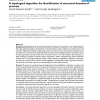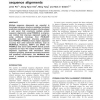115 search results - page 4 / 23 » Regression analysis of multiple protein structures |
BMCBI
2007
14 years 11 months ago
2007
Background: Identification of the structural domains of proteins is important for our understanding of the organizational principles and mechanisms of protein folding, and for ins...
122
click to vote
NAR
2007
14 years 11 months ago
2007
Multiple sequence alignments are essential in homology inference, structure modeling, functional prediction and phylogenetic analysis. We developed a web server that constructs mu...
BMCBI
2006
14 years 11 months ago
2006
Background: Since the publication of the first draft of the human genome in 2000, bioinformatic data have been accumulating at an overwhelming pace. Currently, more than 3 million...
HPDC
2010
IEEE
15 years 22 days ago
2010
IEEE
A common task in biological research is to predict function for proteins by comparing sequences between proteins of known and unknown function. This is often done using pair-wise ...
BMCBI
2008
14 years 11 months ago
2008
Background: A multiple sequence alignment (MSA) generated for a protein can be used to characterise residues by means of a statistical analysis of single columns. In addition to t...


